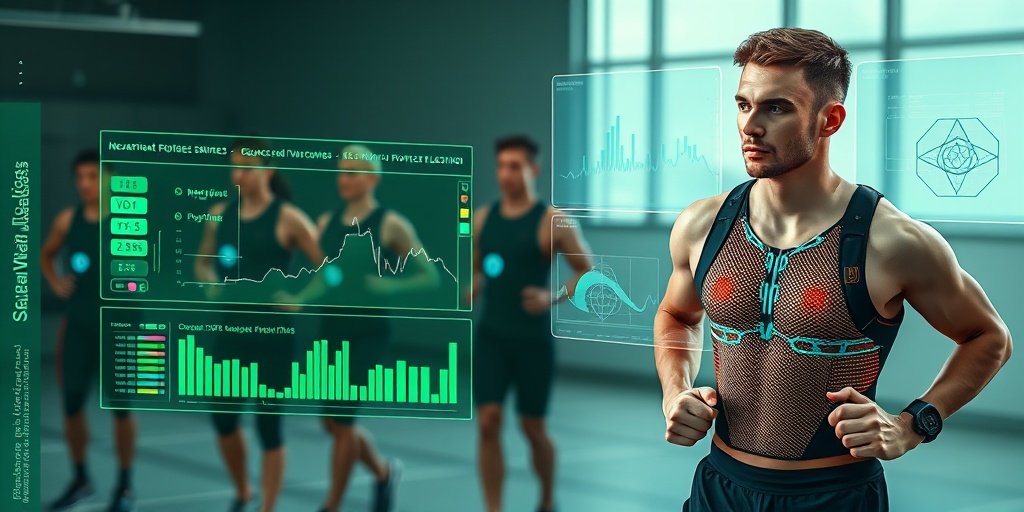⚡ Quick Summary
This pilot study explored the use of machine learning (ML) models to estimate oxygen uptake (VO2) in team sports athletes using data from wearable sensors. The results indicated that LSTM models provided the most accurate predictions, showcasing the potential for real-time physiological monitoring in sports.
🔍 Key Details
- 👥 Participants: Six healthy male team sports athletes
- 📊 Data Collection: Inertial measurement units (IMU), heart rate monitors, and breathing rate sensors
- ⚙️ ML Models Tested: Multiple linear regression (MLR), XGBoost, LSTM, CNN, MLP
- 🏆 Best Performance: LSTM with raw IMU data (RMSE: 4.976, MAE: 3.698)
🔑 Key Takeaways
- 📈 LSTM models achieved the highest accuracy in estimating VO2.
- 💡 MLR models remained competitive, especially with engineered features.
- 🔧 Multi-sensor configurations improved prediction accuracy significantly.
- ⏱️ Real-time monitoring of VO2 is now feasible with wearable technology.
- 🏃♂️ Insights into physiological demand during team sports can enhance training and performance.

📚 Background
In team sports, accurately assessing an athlete’s training status is essential for optimizing performance and minimizing injury risks. Traditional methods of measuring oxygen uptake (VO2) can be invasive and impractical during training sessions. The integration of wearable sensors and machine learning offers a promising alternative for non-invasive, real-time monitoring of athletes’ physiological demands.
🗒️ Study
Conducted with six healthy male athletes, this pilot study aimed to evaluate the feasibility of using various machine learning models to estimate VO2 during simulated team sports activities. Data were collected through a combination of inertial measurement units (IMU), heart rate monitors, and breathing rate sensors during incremental fitness tests, providing a comprehensive dataset for analysis.
📈 Results
The study found that LSTM models utilizing raw IMU data yielded the most accurate predictions of VO2, with a root mean square error (RMSE) of 4.976 and a mean absolute error (MAE) of 3.698. Interestingly, MLR models also demonstrated competitive performance, particularly when using engineered features, highlighting the versatility of different modeling approaches in this context.
🌍 Impact and Implications
The findings from this study suggest that machine learning can significantly enhance the monitoring of VO2 in real-time, providing valuable insights into athletes’ physiological demands during training. This advancement could lead to improved training regimens, better performance outcomes, and a reduction in injury risks, ultimately transforming how coaches and athletes approach training in team sports.
🔮 Conclusion
This pilot study underscores the potential of machine learning in sports science, particularly for non-invasive monitoring of physiological parameters like VO2. As technology continues to evolve, the integration of wearable sensors and advanced analytics could revolutionize athlete training and performance assessment, paving the way for a new era in sports science.
💬 Your comments
What are your thoughts on the use of machine learning for monitoring athletes’ performance? We would love to hear your insights! 💬 Leave your comments below or connect with us on social media:
Estimating oxygen uptake in simulated team sports using machine learning models and wearable sensor data: A pilot study.
Abstract
Accurate assessment of training status in team sports is crucial for optimising performance and reducing injury risk. This pilot study investigates the feasibility of using machine learning (ML) models to estimate oxygen uptake (VO2) with wearable sensors during team sports activities. Six healthy male team sports athletes participated in the study. Data were collected using inertial measurement units (IMU), heart rate monitors, and breathing rate sensors during incremental fitness tests. The performance of different ML models, including multiple linear regression (MLR), XGBoost, and deep learning models (LSTM, CNN, MLP), was compared using raw and engineered features from IMU data. Results indicate that while LSTM models with raw IMU data provided the most accurate predictions (RMSE: 4.976, MAE: 3.698 [Formula: see text]), MLR models remained competitive, especially with engineered features. Multi-sensor configurations, particularly those including sensors on the torso and limbs, enhanced prediction accuracy. The findings demonstrate the potential of ML models to monitor VO2 noninvasively in real-time, offering valuable insights into the internal physiological demand during team sports activities.
Author: [‘Sheridan D’, ‘Jaspers A’, ‘Viet Cuong D’, ‘Op De Beéck T’, ‘Moyna NM’, ‘de Beukelaar TT’, ‘Roantree M’]
Journal: PLoS One
Citation: Sheridan D, et al. Estimating oxygen uptake in simulated team sports using machine learning models and wearable sensor data: A pilot study. Estimating oxygen uptake in simulated team sports using machine learning models and wearable sensor data: A pilot study. 2025; 20:e0319760. doi: 10.1371/journal.pone.0319760